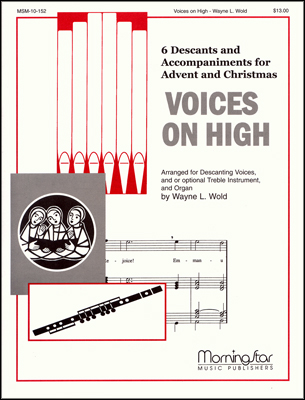This ancient advent hymn originated in part from the “Great ‘O’ Antiphons,” part of the medieval Roman Catholic Advent liturgy. On each day of the week leading up to Christmas, one responsive verse would be chanted, each including a different Old Testament name for the coming Messiah. When we sing each verse of this hymn, we acknowledge Christ as the fulfillment of these Old Testament prophesies. We sing this hymn in an already-but not yet-kingdom of God. Christ's first coming gives us a reason to rejoice again and again, yet we know that all is not well with the world. So along with our rejoicing, we plead using the words of this hymn that Christ would come again to perfectly fulfill the promise that all darkness will be turned to light. The original text created a reverse acrostic: “ero cras,” which means, “I shall be with you tomorrow.” That is the promise we hold to as we sing this beautiful hymn.
Text:
Each verse of this hymn refers to Christ by various Old Testament titles, thus exemplifying Christ as the fulfillment of Old Testament prophecy. In addition to its anticipation of Christ’s birth, the hymn can also be interpreted to refer to the Second Coming. Van Trapp’s alternate text expounds on this theme:
“O Come, Messiah, come again
And rid the world of death and sin.
Return Thou risen Savior and King,
That heav’n and earth at last may sing.”
(Hymnal for Worship and Celebration: Word Music, 1986).
Fifteen hundred years gives a lot of time to make changes to the text, and it turns out there aren’t many hymnals that have exactly the same words. Like the original Latin poem, J.M Neale’s translation from 1851 contained seven stanzas; today many modern hymnals contain only five. You probably won't come across any big disputes over which text you use; most of the changes have occurred gradually and the versions we now use have simply been passed along in our various traditions. A refrain was also added to the original text that is familiar and oft-sung today: “Rejoice, rejoice, Immanuel shall come to you, O Israel.”
Tune:
“O Come, O Come, Immanuel” is set to the tune VENI EMMANUEL, adapted by Thomas Helmore. This haunting and pleading tune beautifully supports the words of longing found in the text, with the hopeful change into the refrain. When arranging, be sure to highlight the juxtaposition between the verses and the refrain that is powerfully moving – the verses should evoke a sense of deep, deep longing, and the refrain then acts as a response of assurance to that plea. This could be expressed by singing the stanzas in unison and the refrain in harmony, or using lighter instrumentation on the verses and get louder on the refrain, as well changing from minor accompaniment to major.
Despite being an old hymn, “O Come, O Come, Immanuel” is easily adaptable for a worship team. The hymn lends itself to various interpretations, but is perhaps most effective with soft, cascading piano accompaniment in the upper registers and soft acoustic guitar. Auxiliary instruments such as violins and flutes can also be used effectively; music director David Schaap recommends intermittently ringing hand bells throughout the piece to affect an ethereal feel (Schaap, David. "Hymn of the Month," Reformed Worship. The plainchant is also quite effective when simply sung a cappella, especially if led by a skilled choir. You can find many examples of contemporary interpretations to inspire your own arrangements. Here are just a few:
- Casting Crown’s beautifully cascading piano and violin instrumental which really highlights the juxtaposition between verse and refrain
- Sufjan Steven’s arrangement accompanied by banjo
- BarlowGirl’s combination of beautiful vocals and lush strings
When/Why/How:
In Hymnal for Worship and Celebration, “O Come, O Come, Immanuel” is part of a brief worship sequence for an Advent service that begins with a responsive reading and connects the hymns “O Come, O Come, Immanuel,” “Come Thou Long-Expected Jesus” and “Joy to the World!” with musical segues. Additionally, the hymn may be sung antiphonally, with a choir or soloist introducing the opening refrain (possibly in the original Latin) and the congregation joining in on the first stanza. David Schaap recommends singing each verse separately followed by a reading of the corresponding Old Testament prophesy (perhaps over ambient piano or organ transitions). While the ‘O’ Antiphons would have been sung each day during the week before Christmas, it is also possible to sing two stanzas each week of Advent, a tradition some Catholic churches hold: stanzas 1 & 2 on the first Sunday, 3 & 4 on the second Sunday, 5 & 6 on the third Sunday, and 1 & 7 on the fourth Sunday.
Other suggested music:
- Wold, Wayne L. Voices on High, Set 1-Six Descants and Accompaniments for Advent and Christmas - for Organ and Congregation, with optional C Instrument or Choir
- Hopson,Hal H. O Come, O Come, Emmanuel - for Two-Part Mixed Voices
- Fettke, Tom. Veni Emmanuel - Choir anthem of "O Come, O Come Emmanuel" paired with "Tommorow Shall Be My Dancing Day"
- Daigle, Gary and The Dameans. Come, O Come, Emmanuel/O Antiphons - for Congregation and Piano with optional Guitar
- Roberts, Philip. O Come, O Come, Emmanuel - for Handbells
- Dobrinski, Cyntyia. O Come, O Come, Emmanuel - for Handbells
Laura de Jong,
Hymnary.org


 My Starred Hymns
My Starred Hymns








